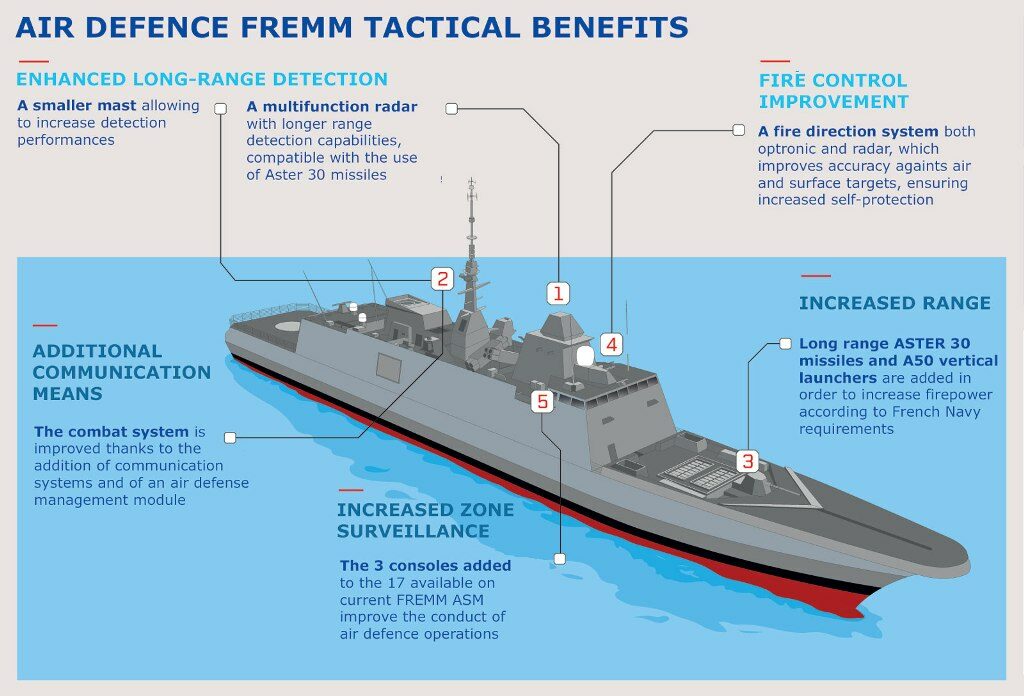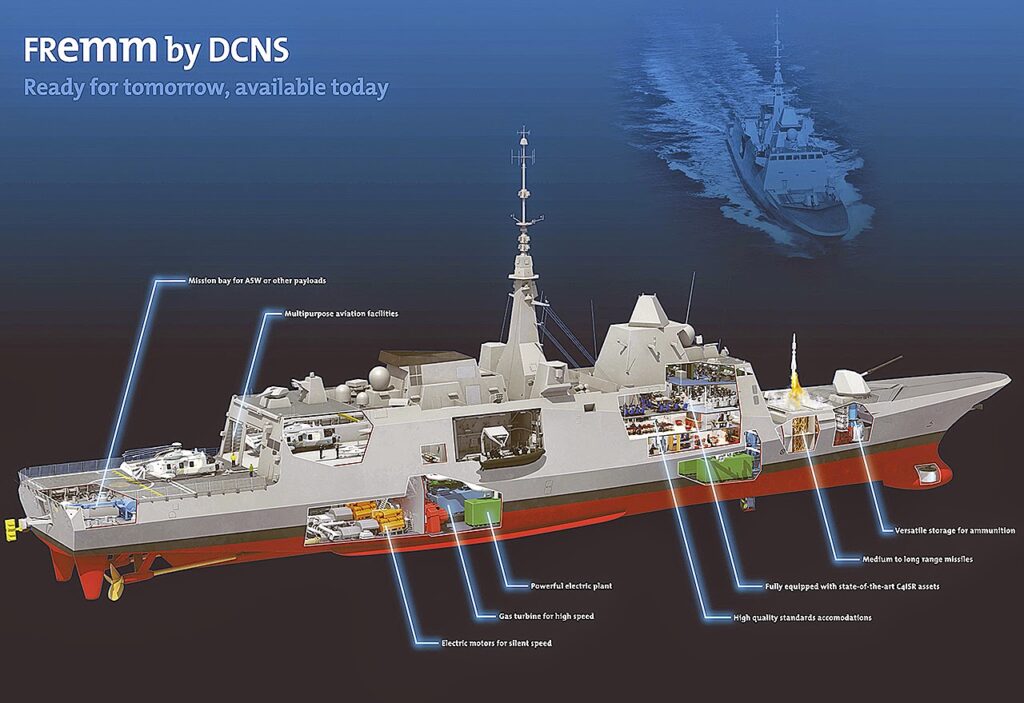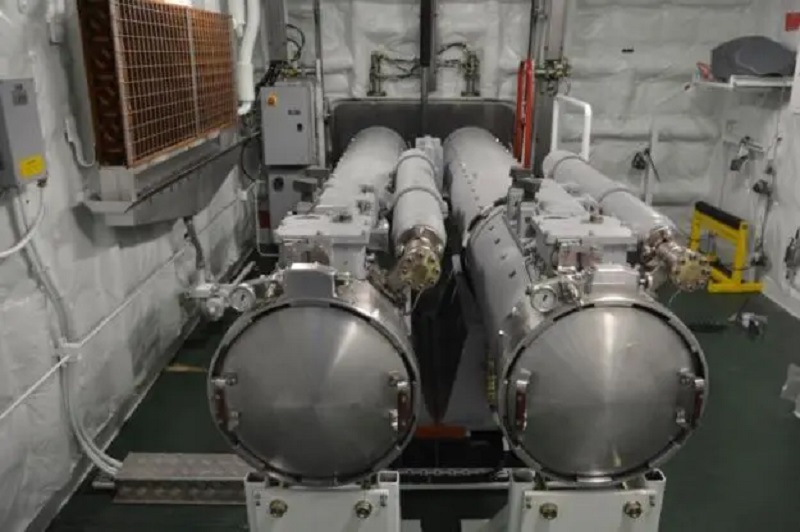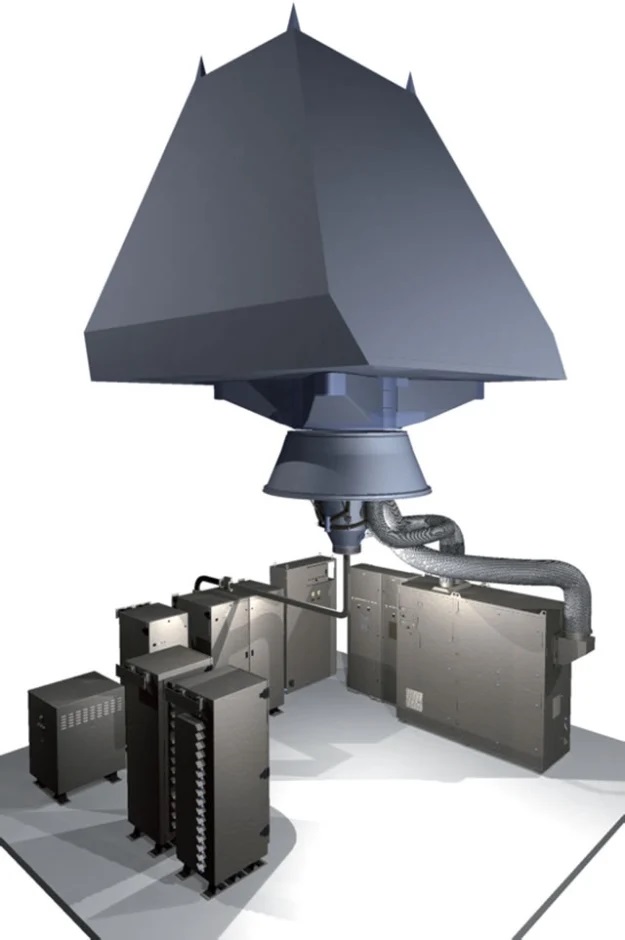The Franco-Italian FREMM (Fregate Europeenne Multi-Mission) frigates are, as the name suggests, a common European design for building multi-role frigates. The frigates were proposed to be built in three different configurations, anti-submarine warfare, general service and land-based force projection to replace different classes of ships in both navies. Of the 27 frigates that were to be built according to the original plan, only 18 were built for the French and Italian Navy out of 8 and 10 respectively, after the French Navy reduced the number by nine.
Unlike Horizon-type anti-aircraft destroyers where all ships had a common configuration, FREMM frigates had different electronics, weapons systems and propulsion configurations. As a result, the hull design lines remain the same, even though the Italian frigates are two meters longer, while the superstructure configuration is completely different to accommodate the different systems. For this reason, we will focus in this article on the French composition and we will refer to the Italian composition in a later article.
The frigates that rolled out of the DCNS Naval Group's shipyards today were built in two configurations, eight ships of the anti-submarine version, the Aquitaine class, including six for the French Navy and one each for the Egyptian and Moroccan Navy. By reducing the number of Horizon AA destroyers to just two ships, the French Navy's initial requirement for ships with regional defense capabilities was not met. Thus, the last two ships of the French Navy were built in the anti-aircraft version of the Fremm Defense Aerienne (FREDA), Alsace class. The ships were built in French service between 2010 when the first ship was scrapped until November 2023 when the last ship D657 Lorraine entered service.

The ships have a total length of 142.2 metres, a width of 20 metres, an average draft of 5 metres, and a maximum draft of 7.6 metres, with a full load displacement of 6,000 tonnes. The frigates are designed with increased stealth features to reduce electromagnetic, thermal and acoustic signatures. The hull and superstructure lines connect seamlessly between the two parts avoiding creating different sizes and angles that would enhance the E/M effect while also inviting redirection of enemy radar signals away from the source. The hull is divided into three decks and the superstructure into two parts as well as the ship's bridge. The ship's acoustic signature is reduced due to the ship's propulsion system and the fact that all engines are housed in special chambers to reduce thermal and acoustic signature and on special anti-vibration mounts.

paying off
The ship's propulsion is a CODLOG (combination of diesel electric or gas) combination of electric propulsion with an air turbine where electric propulsion is used for low speeds and air turbine for high speeds. The vessel has two Jeaumont Electric electric motors with an output of 2,500 kilowatts each that derive power from the vessel's four MTU 16V4000 M63L electric motors that deliver 2,240 kilowatts at 1,800 rpm. The ship has two shafts driving an equal number of fixed propellers and an electric motor is mounted on each shaft. The wind turbine is a General Electric LM 2500 G4+ that delivers 35,320 kW at 3,600 rpm. The two axles are driven by a RENK cross-connection gearbox. The maximum speed of the vessel is 27 knots while with electric motors the maximum speed reaches 16 knots giving a cruising radius of 6000 nm. The fuel transported is about 500 tons. The combination of electric propulsion and fixed-pitch propellers significantly reduces the acoustic effect, which in turn helps reduce the probability of ship detection and during anti-submarine operations. This, combined with the latest sonar technology from Thales, created the ideal A/V frigate for NATO, winning the appropriate title two years in a row.

Weapon systems
The layout of the weapon systems is as follows. The Leonardo OTO Melala 76 mm SR dual-role naval gun is mounted in the bow, followed by four vertical silver launchers of eight cells each. The A/V frigates are equipped with 2×8 Sylver A43 launchers for Aster-15 missiles and 2×8 Sylver A70 launchers for Scalp Naval cruise missiles. In contrast, the anti-aircraft frigates are equipped with 4×8 Sylver A50 launchers for the Aster15/30 anti-aircraft missiles. From now on, the rest of the weapon systems for the two subclasses are the same. Eight MM-40 Block3/3c Exocet anti-ship missiles are mounted on the mezzanine, two B-515 fixed torpedo tubes for MU90 torpedoes and two 20 mm RWS Narwal are mounted starboard and left on the undercarriage. At the stern there is a helipad and helipad that can accommodate an MH-90 marine helicopter. The last line of defense against incoming threats are SLAT systems equipped with CANTO-V anti-torpedo traps and NGDS anti-missile traps.

electronics
The ship's primary sensor is the PESA Herakles 3D passive rotating radar that transmits in the S-band. The radar has a maximum range of air targets at 250 km and sea targets at 80 km and can handle up to 400 tracks simultaneously. A more powerful version of the radar was installed on the two anti-aircraft frigates. It also has two Terma Scanter 2001 marine radars. One is mounted above the bridge and the other above the helicopter hangar for 360 degree sector coverage.

In the field of electro-optics, a Thales Artemis IRST system with 360-degree coverage was installed on the main mast. The Artemis IRST operating in the mid-wave infrared range is particularly suitable for detecting long-range missiles in the maritime environment. While ARTEMIS is highly effective against these current and emerging missile threats, it also enhances a ship's self-defense against other conventional air and surface threats. This includes combat aircraft, drones and surface ships, including asymmetric FACs (Fast Attack Craft). ARTEMIS also provides 24-hour situational awareness via infrared video output with image enhancement and AI algorithms for operator support and can manage and classify up to 200 traces. The O/O fire control system is Sagem Vigy MM.

In the field of air and acoustic vehicle warfare, the French ship Fremm has a UMS 4110 CL hull sonar with a range of up to 35 km and a towable, variable-depth CAPTAS 4, weighing 35 tons and having a spatial footprint at the stern of the ship. 84 square meters. CAPTAS 4 has a maximum detection range of 150 km and is fully connected to the ship's hull sonar providing 360 degree coverage. You can read more detailed information about sonar here.
The frigate has HF, UHF VHF communications, Link11 and Link 16 data links as well as satellite communications with the Syracuse 3 and Syracuse 4 systems in the AAW version. In terms of electronic warfare, it has the Altesse system for C-ESM, and it has the R-ESM and R-ECM system through the Nettuno 4100 system from the Italian company Eletronica. The heart of the ship is the SETIS system, which manages all of the ship's information and weapons systems. In the battle information center there are 17 system control units. Three additional controllers have been added to AA warships to better manage the AA's operations arm.

“Avid problem solver. Extreme social media junkie. Beer buff. Coffee guru. Internet geek. Travel ninja.”





More Stories
“Recycling – Changing the water heater”: the possibility of paying the financing to the institution once or partially
Libya: US General Meets Haftar Amid Tensions Between Governments
New tax exemption package and incentives for business and corporate mergers..